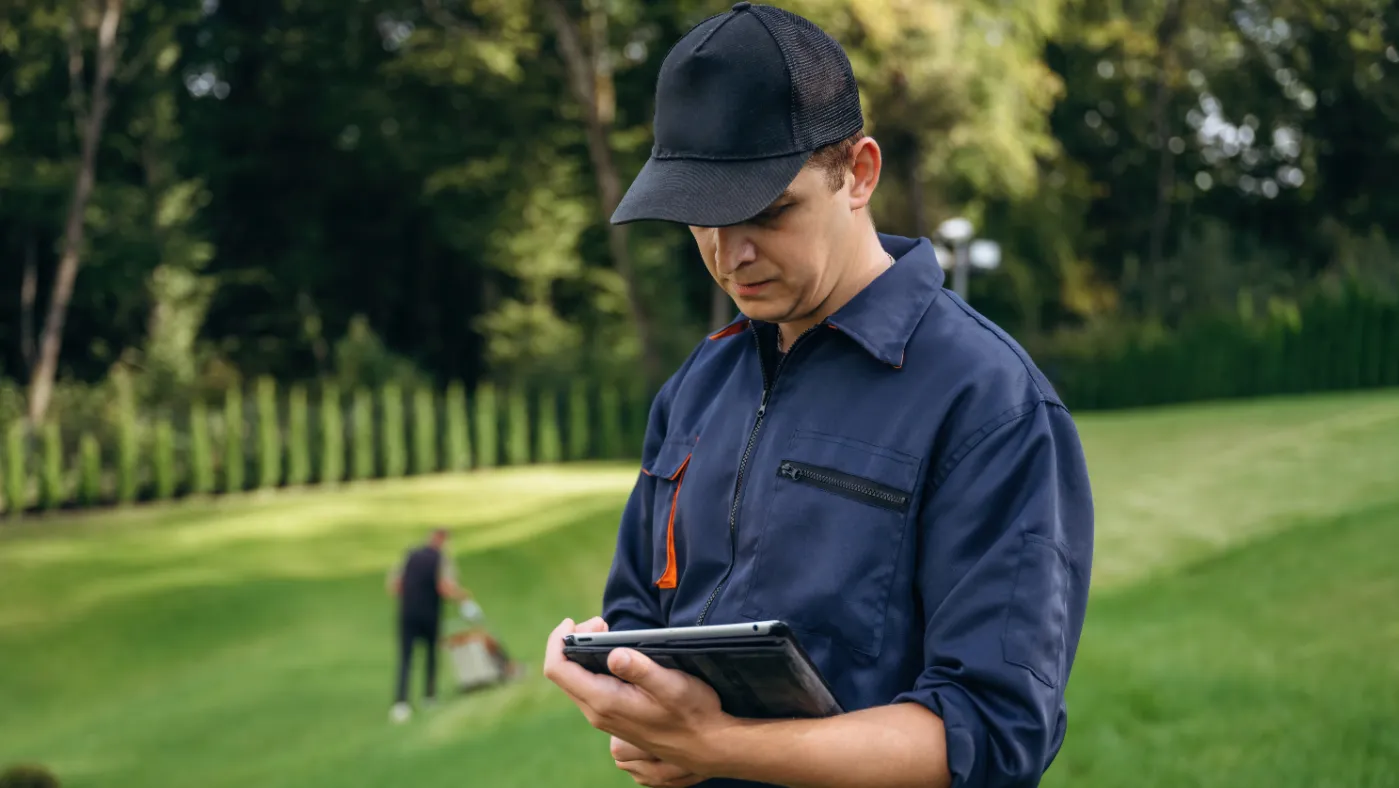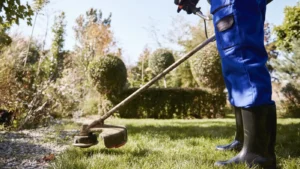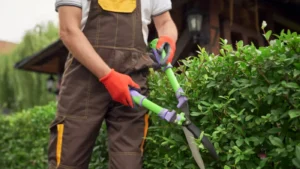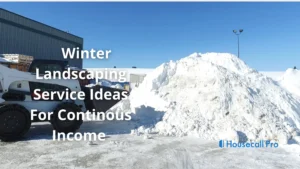Want to win more jobs with less effort?
Grow your business and send quick quotes with our home service software.

Want to see your potential revenue?
See what businesses like yours earn with Housecall Pro in 1 - 2 minutes.

Your timing couldn’t be better if you’re considering starting a tree service business. According to a report by IBISWorld, the U.S. tree service industry is worth billions presently—a staggering $35.6 billion to be exact. The sector will continue to grow with homeowners, commercial properties, and town councils increasingly depending on professionals to handle tree service tasks such as routine pruning and storm cleanups.
If you need a reason beyond market numbers and steady income potential, here’s a strong one: starting a tree service business allows you to build something of your own. It could help you give your family the life they deserve, while allowing you to grow on your own terms.
That’s why we built this guide for doers who don’t want fluff or generic advice—just a straight-up action plan that helps you jump right in. We’ll walk you through the 11 key steps of getting your business off the ground so you’ll know how to start a tree service business the right way.
How to Start Tree Care Business in 11 Steps
- Step 1: Become a Certified Arborist (Even if You Don’t Think You Need It)
- Step 2: Create a Tree Service Business Plan
- Step 3: Choose a Business Name You Can Use Online
- Step 4: Register & Get Your Business License for Tree Service
- Step 5: Get the Right Business Insurance for Tree Service Pros
- Step 6: Open a Business Bank Account & Set Up Bookkeeping Early
- Step 7: Finance Your Tree Service Business Without Drowning in Debt
- Step 8: Price Your Tree Services to Make a Profit—Not Just Cover Costs
- Step 9: Get the Right Tree Service Equipment Without Wasting Money
- Step 10: Market Your Tree Service Business and Get Clients Fast
- Step 11: Hire Your First Crew Without Losing Your Mind
- Bonus: Use Housecall Pro to Run and Grow a Tree Service Business
- You’re Not Just Starting a Business—You’re Building a Legacy
Step 1: Become a Certified Arborist (Even if You Don’t Think You Need It)
An arborist certification separates Chuck-with-a-truck contractors from the real tree service pros. Even though you don’t technically need it to run a successful tree service business, it inspires major trust and instant credibility among prospects, especially if you’re eyeing municipal and commercial contracts that pay big.
The International Society of Arboriculture (ISA) is the gold standard for arborist certification in the U.S.
How to Get Certified
Here’s how you can acquire your certification through the ISA:
- Three years of full-time work experience in arboriculture, or equivalent education in the field, is a prerequisite for certification.
- If you meet the above conditions, you can start prepping for the ISA’s Certified Arborist exam, which covers everything from tree biology, pruning, and safety to soil management. ISA has several preparatory resources and online courses to help you study for the exam.
- The exam’s fees vary according to membership, ranging from $170 to $280.
Once you get your business license for tree service, you must complete a specific number of continuing education units every three years to stay certified.
Step 2: Create a Tree Service Business Plan
What to Include in Your Business Plan for Tree Service
- Define your niche: Whether you want to start a tree removal service, focus on residential trimming and pruning, or specialize in emergency storm cleanups, choose a niche early so that you can develop a targeted marketing strategy accordingly and gear your equipment toward specific jobs.
- Sort your financials: Map out your startup costs (truck, chipper, PPE, licenses, etc.) and estimate your monthly overhead and recurring expenses (fuel, insurance, and equipment maintenance). Based on these figures and your pricing strategy, set realistic revenue goals for the first year.
- Research the competition: Scope out your local competitors and identify the services they offer. Digging deep into competitor data will help you spot gaps and set a clear, unique selling point (USP) for your tree business—whether certified arborist care, emergency response services, or transparent pricing.
Is Tree Service a Good Business to Start?
Starting a tree company is an excellent opportunity. Here’s why:
- Demand for tree care services shows no sign of slowing, especially in suburban areas with mature trees or regions with adverse weather histories.
- There is a low barrier to entering the tree service business. You don’t need a huge crew or fleet to start. You just need some basic equipment and botanical knowledge.
- Once you establish your business, you can scale it and land bigger projects, from land maintenance contracts with HOAs to annual pruning contracts. The result? Predictable and recurring income.
Step 3: Choose a Business Name You Can Use Online
Name Ideas That Work for Tree Service Companies
Pick a simple and local name that reflects what you do and the region you serve—for example, “Evergreen Tree Co.” or “Northside Valley Tree Experts.” This can also help clients find you easily in local online searches.
Clever as they may be, avoid puns or gimmicky names (e.g., Tree Musketeers) that dilute the seriousness of your brand. Also, avoid locking yourself into service or pricing-related names like “Affordable Tree Removals.” This can limit future expansion and cause issues if you want to offer premium services later.
Check Availability Before You Fall in Love with a Name
- Do a quick check using sites like Namechk or GoDaddy to confirm your domain name is available. Ideally, you want to match your domain to your business name (e.g., www.evergreentreeservice.com)
- Run your business name through your Secretary of State business name registry to ensure no other business has the same registered name in your state.
Step 4: Register & Get Your Business License for Tree Service
You’ll need to choose a business structure for your tree service business, whether an LLC or sole proprietorship. Most tree care startups choose a Limited Liability Company (LLC) setup, as it is affordable, easy to maintain, and most importantly, keeps your personal finances and business liabilities separate.
Next, register your business with the Secretary of State. You’ll receive an Employer Identification Number (EIN) from the IRS that helps you open a business bank account, file taxes, and hire employees. Apply for an EIN for free at irs.gov.
Common Permits and Licensing Requirements
Some states and municipalities mandate arborist licenses and permits before you can offer tree care services. Some states also need you to show proof of insurance (for general liability) before they can issue a permit.
Others require you to have workers’ compensation coverage if you have employees, even part-time workers. Refer to local government websites or small business development centers for updates and specific information.
Step 5: Get the Right Business Insurance for Tree Service Pros
What Tree Service Business Insurance Do You Need?
- A general liability insurance is a baseline plan that helps cover property damage, third-party injuries, and legal fees. Most clients request proof of this insurance before you begin work.
- Workers’ compensation insurance is necessary in most states. It protects both your workers and your business in case of on-site injuries.
- You need commercial auto insurance to cover work trucks or other vehicles you use for job site transportation, as personal auto insurance does not cover commercial vehicles.
- Protect the tools of your trade against theft, loss, and damage with equipment insurance.
Tree Service Business Insurance Cost: What to Expect
Insurance costs can vary depending on your service location, the nature of your services, and your crew size.
- Expect to pay around $3,800 per year for general liability and workers’ compensation insurance for a two to three-person team.
- Commercial auto insurance can cost you around $2,400 per year.
- Tree care businesses typically pay an average of $681 annually for tools and equipment insurance.
Some trusted insurance providers for tree service insurance include:
Step 6: Open a Business Bank Account & Set Up Bookkeeping Early
Why It Matters
- Financial separation, i.e., keeping business and personal funds separate, is a wise practice for your tree service business. A separate business bank account helps prove that you’re running a legitimate business.
- A dedicated business account makes it easier to track your income, deduct expenses, and file taxes without involving personal finances. Most importantly, it helps protect your LLC status.
- Potential customers are more likely to trust and quickly pay a legit tree care company called “Northside Valley Tree Services, LLC” than write a personal check under the owner’s name.
Set Up Simple Accounting Tools
Tools like QuickBooks Online help you track income, manage multiple receipts, and keep invoices organized. Housecall Pro is another popular tool that helps you manage tree servicing jobs easily—whether to track payments, create estimates and send invoices, or generate regular financial reports.
Make automated tools a part of your workflow, especially to manage recurring expenses such as equipment and vehicle leases, or to set up auto-billing for regular clients. They can help you track profits, identify hidden costs, and refine your pricing strategy.
Step 7: Finance Your Tree Service Business Without Drowning in Debt
How Much Does It Cost to Start a Tree Service?
Here’s a rough breakdown of the costs associated with a tree service startup:
- You can reduce startup costs by initially buying used equipment. Basic equipment costs, including used trucks and trailers, chainsaws, climbing gear, and woodchippers, can range between $25,000 and $50,000.
- Add a minimum of $20,000 in operating costs for business insurance, licensing, website, marketing, and software (CRM and accounting).
Funding Options
Local banks and credit unions commonly offer startup business loans and lines of credit. They offer flexible repayment options and are ideal for initially covering variable expenses, like fuel and payroll.
The Small Business Administration (SBA) backs startups and provides microloans of up to $50,000 through SBA funding intermediaries. The SBA also offers lower interest rates than commercial banks. Check with an SBA-approved intermediary in your area to apply for one.
Step 8: Price Your Tree Services to Make a Profit—Not Just Cover Costs
Proven Tree Service Pricing Strategies
Quoting a flat rate helps you quote faster while making it easier for clients to understand the pricing and pay sooner. However, flat rate pricing is advantageous only for predictable jobs like a simple tree removal.
When the job is more complex (e.g., power line clearances or tree removal with inaccessible roots) and requires more hours, an hourly rate is the best way to go. While pricing a job, also include variables such as:
- Tree size, height, species, and root embedding
- Site access, i.e., whether the site is enclosed in tight spaces or fenced yards
- Nearby hazards such as power lines or buildings
- Any specialized equipment you may need for the job, such as a bucket truck or a climber
- Crew size and the time you need to finish the job
You can offer service bundles for combined jobs, such as trimming and removal, or discounted rates for more predictable and recurring jobs, such as seasonal tree pruning. You can also partner with HOAs to win long-term contracts for annual maintenance plans.
Tools to Help You Quote Smarter
Housecall Pro’s quoting tools can help you build branded estimates in minutes. It can also help you send them to multiple clients, track them, and get quick approvals.
Housecall Pro allows you to build estimates from saved templates for common and recurring jobs like tree removals. It helps you save precious time and set more standardized pricing. While quoting, you can easily include optional upsells and add-ons, such as stump grinding and debris hauling.
Step 9: Get the Right Tree Service Equipment Without Wasting Money
Must-Have Equipment to Start
Buy these smart and essential tools to get your first few jobs right:
- At least two chainsaws: one for ground cuts (16-20”) and one lightweight saw for climbing
- Safe climbing gear, including harness, ascenders, carabiners, and flip lines
- PPE kits for additional safety. These should include helmets with face shields, gloves, safety glasses, steel-toe boots, and chainsaw chaps.
- Wood chippers to speed up the cleanup process while saving time on dump runs
- Pole saws and ropes for limb removal jobs in hard-to-reach areas
- First aid kits and safety signage to help keep your crew safe and your job site OSHA-compliant
Where to Buy
Used Gear: Check secondhand marketplaces like Craigslist and Facebook Marketplace to find used gear. You can also scour local heavy-equipment auctions to source chainsaws and trailers at a fraction of the retail price.
Lease-to-Own Options: Pay off your equipment costs while earning with easy lease-to-own options. Sites like Vermeer and Bandit offer lease deals and financing options on chippers and stump grinders.
Safety Compliance: Whether you’re buying used or new equipment, it must pass OSHA checks. Avoid using faulty gears to save both fines and lives.
Step 10: Market Your Tree Service Business and Get Clients Fast
Local Marketing Strategies That Work
Claim your Google Business Profile (GBP). This free yet important step can help you get local eyes on your business. Complete your profile by adding service hours, service locations, photos, contact information, and a few customer reviews.
Leave branded yard signs and door flyers after jobs or turn your truck into a moving ad billboard. Add a compelling call-to-action on all marketing material that prompts prospects to take action, e.g., “Call Us for Tree Removals.”
Team up with local partners, whether landscapers, lawn care businesses, or realtors, to expand your lead network.
Digital Marketing Essentials
- Set up a professional website that enables online bookings, replete with information about your services, rates, and service areas. Skip the technical website-building process by using tools like Housecall Pro. It can help you get an integrated booking page up and running within a day—no developer required.
- Invest money in Facebook and Google ads using high-intent keywords like “tree removal near me” or “emergency tree trimming” to gain visibility among local homeowners.
- Online reviews are gold. Ask every satisfied customer to leave a 5-star review. Use Housecall Pro to help you automate the review process. It automatically sends review requests to customers by text or email.
Step 11: Hire Your First Crew Without Losing Your Mind
When to Hire
Check if you’ve been booked consistently for several weeks or are turning down more work due to limited manpower. It clearly shows that you need more hands to help handle incoming business.
Also, it’s time to expand the team if you’re consistently risking safety at each job, whether with high climbs or heavy lifts.
How to Find Reliable Tree Workers
Checking in with vendors at your local arborist supply shop or landscaping rental store can connect you with skilled workers. Alternately, you can post in Facebook groups for arborists or local tradespeople.
You may also want to consider hiring highly motivated apprentices. It gives you a chance to train them from the ground up, especially for basic ground crew tasks. With the right safety training per OSHA-compliant practices, these novices can grow into their role and become loyal crew members in time.
Pay and Retention Tips
Hourly pay is ideal for new trainees or jobs with unpredictable variables (e.g., storm damage cleanups). Per-job pay works best when the scope of the job is clear and predictable, like yard tree trimming.
Housecall Pro makes job scheduling and payment easier. For example, the tool’s drag-and-drop scheduling helps you assign jobs based on crew strengths. It also tracks the time that each crew member spends on the job with digital time logs, making hourly payouts accurate and transparent.
Not just that, you can share job details, scope, and client notes with your team directly through the mobile app, ensuring the team is well-aligned. When job expectations and outcomes are clear, your crew is more likely to trust you and stay on long-term.
Bonus: Use Housecall Pro to Run and Grow a Tree Service Business
What Do You Need to Run a Tree Service Business Smoothly?
When you’re juggling quotes, scheduling, doing fieldwork, and managing a team, you need a well-oiled system that’s:
- Speedy
- Accurate
- Results in fewer mistakes
You can achieve this by using the right software to grow your tree service business and stay organized.
Housecall Pro Helps Tree Service Businesses:
- Send fast, professional quotes: Creating branded estimates has never been easier. Use templated estimates to send quotes in minutes via your phone and win more jobs on the spot.
- Automate scheduling: Schedule jobs based on crew or location. Brief your team to avoid miscommunication and notify clients automatically when your crew is on the way.
- Get paid faster: Housecall Pro features built-in payment systems, such as credit card and ACH, to help you collect payments through a single device on-site.
- Manage reviews and rack up repeat business: Housecall Pro sends review requests to happy customers so they can post positive comments about your business immediately after the job, not months later.
Get In Touch: 858-842-5746
Let us earn your trust
On average, Pros increase monthly revenue generated through Housecall Pro by more than 35% after their first year.
See plan options and feature breakdown on our pricing page.
You’re Not Just Starting a Business—You’re Building a Legacy
Starting a tree service business is just the tip of the iceberg. With each new equipment you buy or each job you win, you’re paving a path to financial freedom. To make it all the way through, you need the right equipment, systems, and tools on your side, while also playing it smart and safe.
Ready to grow from a one-person crew to a reliable local business? Start right with Housecall Pro’s efficient tools that help you track your most important job elements, automate marketing, and scale your business efforts. Start your free 14-day trial today and take your tree care business to new heights—literally.






